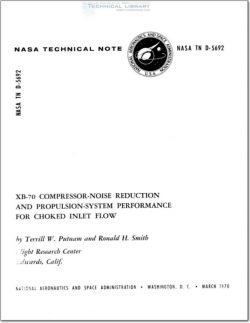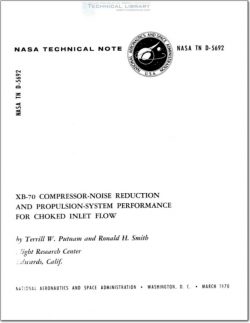NASA-TN-D-5692

- Version
- 175 Downloads
- 1.34 MB File Size
- 1 File Count
- June 15, 2016 Create Date
- June 15, 2016 Last Updated
Compressor Noise Reduction and Propulsion System Performance for Choked Inlet Flow

Aircraft engine noise in the vicinity of populated areas, and particularly near air—
ports, has become an increasingly severe problem. The problem of noise suppression
has been attacked in recent years through many alleviation techniques. The techniques
have ranged from developing quieter engines to acoustically treating engine nacelles
(ref. 1) and altering aircraft flight paths, operating procedures, and propulsion—
system geometries (refs. 1 and 2). One of the latter techniques involves the applica-
tion of variable inlet geometry to aerodynamically choke the inlet. References 3 to 5
discuss results obtained by choking subsonic inlets.
Most supersonic aircraft, because of their wide speed ranges, must incorporate
variable-geometry inlets to match inlet capabilities to engine airflow requirements.
The variable-geometry feature of such an inlet raises the possibility of choking the
inlet for noise suppression during landing. However, supersonic inlets typically have
sharp leading edges for high-speed operation that can grossly affect inlet airflow at
subsonic speeds. The effects of both inlet choking and sharp leading edges were
studied at the NASA Langley Research Center where researchers operated a small
turbojet engine connected to a supersonic inlet (ref. 6). Aerodynamic choking of the
inlet flow was induced and the resultant noise suppression and propulsion performance
measured. Noise suppression in the compressor—blade passing frequencies was
observed to be as high as 20 decibels. Inlet performance was also observed for a
range of inlet centerbody and engine settings.
The present study with the XB-70 airplane was directed toward evaluating inlet
aerodynamic choking as a noise-suppression technique and toward determining the
resultant inlet and engine performance. The XB—70 inlets, with their large size and
Mach 3 design, are typical of future supersonic inlets and are characterized by sharp
leading edges and variable geometry. Tests were made at several power settings
ranging from 60 percent to 100 percent of full rated engine speed and at several throat
areas with the XB—7O on a thrust stand. (A power setting of 87 percent was typically
used during X'B—70 landings.) The measurements were made at Edwards Air Force
Base, Calif. The results of the tests are presented in terms of sound pressure levels,
inlet pressure recovery, and net thrust for a range of engine speeds and inlet throat
settings.
| File | Action |
|---|---|
| NASA-TN-D-5692 XB-70 Compressor Noise Reduction and Propulsion System Perfromance for Choked Inlet Flow.pdf | Download |

Comment On This Post